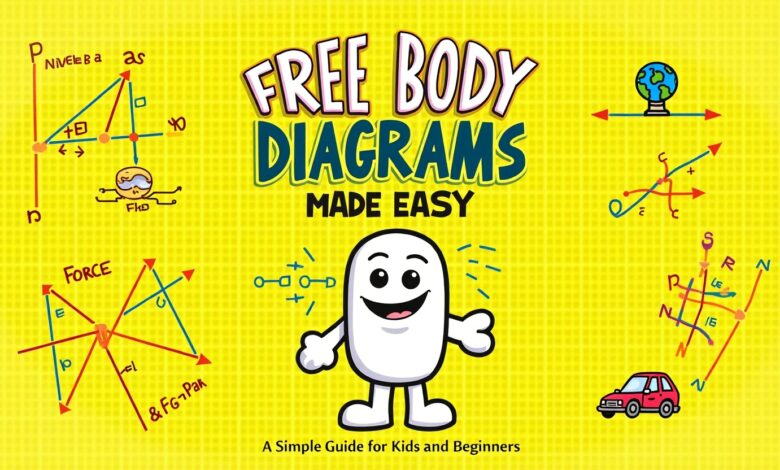Free Body Diagram Made Easy: A Simple Guide for Kids and Beginners

Free Body Diagram is a simple drawing that helps us understand how forces work on an object. If you ever wondered why things move or stay still, a free body diagram can give you the answer. It shows all the pushes and pulls acting on something, like a box or a car.
In this blog post, we will learn about free body diagrams in a fun and easy way. You don’t need to be a science expert. We’ll use simple words, pictures, and real-life examples to help you understand. By the end, you’ll be able to draw your own free body diagram like a pro!
What Is a Free Body Diagram? A Simple Explanation for Beginners
A free body diagram is a picture that shows all the forces acting on one object. It helps us see how and why something moves or stays still. This drawing is very useful in science, especially in physics. You don’t need to be a genius to understand it — it’s just a clear and simple sketch.
Each object is drawn like a small box or a dot. Then, arrows are added to show the direction of every force. The arrows tell us if something is being pushed, pulled, or held up. This helps kids and beginners understand forces in a very easy way.
People use free body diagrams when they want to solve problems about motion. For example, if a car is going up a hill, we can draw a diagram to see what’s pushing or slowing it down. It’s like a map that shows where all the invisible forces are working.
Why Free Body Diagrams Are Important in Science and Real Life
We see forces around us every day, but we can’t see them with our eyes. This is where a free body diagram helps. It lets us draw the invisible forces so we can understand what’s really happening. This is very important in science, especially in physics and engineering.
When you want to know why a car stops or how a ball rolls down a hill, a free body diagram can give you the answer. It breaks the problem into smaller parts. This makes it easier to see what forces are working and how they balance or change the motion.
In real life, engineers use these diagrams to make sure bridges don’t fall or buildings stay strong. They look at all the forces in the diagram before building anything. This helps keep people safe and designs strong.
Learning how to use free body diagrams can help students, builders, and even athletes understand their actions better. It shows how forces affect everything from walking to flying. That’s why it’s such an important skill to learn and practice.
Parts of a Free Body Diagram: What You Must Include
When drawing a free body diagram, you need to add certain parts so it makes sense. The object you are focusing on should be in the center. This is usually a square or circle to show what you are studying. It helps keep everything simple.
Next, you draw arrows to show the forces. These arrows are very important. The direction of each arrow shows where the force is going. The size of the arrow tells us how strong the force is. Bigger arrows mean stronger forces, and smaller arrows mean weaker ones.
You also need to label each force. You can write names like gravity, friction, or push. This helps others understand your drawing. If someone else looks at your diagram, they should know exactly what every arrow means without asking questions.
Every free body diagram should be neat and easy to read. It does not have to be perfect, but it should show all the main forces clearly. Keep it clean and simple, and don’t add too many extra things. This way, it will help you solve problems faster.
How to Draw a Free Body Diagram Step by Step
To draw a free body diagram, start by picking one object. It could be a ball, box, car, or anything you want to study. Draw it as a simple shape like a square or circle in the center of your page. This will be your starting point.
Next, think about all the forces acting on that object. Is something pushing it? Is it being pulled by gravity? Is the ground holding it up? For each force, draw an arrow starting from the object and pointing in the direction the force is going.
Label each arrow with the type of force. Some common forces are:
- Gravity – pulls things down.
- Normal force – pushes up from a surface.
- Friction – slows things down when they slide.
- Applied force – pushes or pulls from a person or machine.
Keep the diagram clean. Use a ruler if you want straight arrows. Make sure all your arrows start at the object and point away. Don’t forget to label clearly. With just a few steps, you now have a simple but smart free body diagram!
Free Body Diagram Examples from Everyday Life
Let’s look at some easy examples of a free body diagram from real life. These help us understand how the world works. A great example is a book sitting on a table. There are two main forces. Gravity pulls it down, and the table pushes it up. The arrows go in opposite directions but are equal, so the book doesn’t move.
Another example is a person pushing a box across the floor. You draw the box in the center. Then, you draw arrows to show the pushing force, the friction slowing it down, the weight pulling it down, and the ground pushing it up. It looks simple, but it explains everything.
When a ball is rolling, the diagram shows a forward push and friction that tries to stop it. Gravity pulls it down, and the floor pushes it up. These arrows help us understand why the ball slows down over time.
Using a free body diagram with real-life things makes learning fun and useful. It’s not just for class. You can use it to explain things you see every day. Try it with a bike, a swing, or even while jumping!
Common Mistakes to Avoid in Free Body Diagrams
Sometimes people make small mistakes when drawing a free body diagram. These can make it hard to understand or solve a problem. One common mistake is forgetting to include all the forces. If you leave one out, the diagram won’t show the full picture.
Another mistake is drawing arrows the wrong way. Arrows must point in the direction the force is acting. If they point the wrong way, your diagram will give the wrong answer. Always double-check the direction before drawing.
People also make arrows too long or too short without meaning to. This can be confusing. Arrows should match the strength of the force they show. Bigger force, bigger arrow. Smaller force, smaller arrow. Keep it balanced.
Labeling is also important. If you forget to label your arrows, others won’t understand what they mean. A good free body diagram is clear, simple, and easy to read. Avoid these small mistakes and your diagrams will be very helpful!
Free Body Diagram in Physics: Made Easy for Students
Free body diagrams are used a lot in physics class. They help students learn about motion and forces in a very easy way. If you understand the diagram, it’s easier to solve physics problems like finding speed or stopping something.
In physics, you will see diagrams for cars moving, boxes sliding, and people walking. Each one shows how many forces are working. These pictures help students think clearly and break hard problems into small steps.
You do not need to be perfect in drawing. Just show the main forces and label them. In physics tests, these diagrams are often the first step in solving the question. Teachers love them because they show your thinking process.
Helpful Tips for Physics Students
- Use clean shapes like boxes or circles.
- Keep arrows straight and neat.
- Always label each force clearly.
- Check direction of arrows for accuracy.
Once you practice a few times, physics will start to feel fun and simple. That’s the power of a free body diagram!
Free Body Diagram Practice: Try It Yourself!
The best way to learn a free body diagram is by trying it yourself. Pick an object around you, like a pencil on a desk or a chair on the floor. Draw it as a box in the middle of your paper. Then, think about what forces are acting on it.
Ask yourself: is gravity pulling it down? Is something holding it up? Is someone pushing or pulling it? Draw arrows for each force. Make sure the arrows point in the right direction and are the right size.
You can try different things like:
- A car parked on a hill
- A ball falling through the air
- A swing moving back and forth
- A person standing still
Fun Practice Ideas for Beginners
- Draw objects you see at home like fans, books, or toys.
- Use colors for each force to keep it clear.
- Do group work with friends and compare your diagrams.
- Ask questions about what each arrow means.
Practicing a free body diagram every day will make you better and faster. It’s fun, and it helps you learn how the world works using simple science!
Conclusion
Learning about the free body diagram is like learning a new way to see invisible forces. It helps us know what is pushing or pulling things around us. When you draw arrows for each force, it becomes super easy to understand how things move or stay still.
You don’t need to be a science expert. With a little practice, anyone can draw a free body diagram. It helps in school, real life, and even games! So keep practicing, and soon you will feel like a force expert!
FAQs
Q: What is a free body diagram?
A: A free body diagram is a simple drawing that shows all the forces acting on one object using arrows.
Q: Why do we use free body diagrams?
A: We use them to understand how things move or stay still by showing what forces are working on them.
Q: Do I need to draw it perfectly?
A: No, it doesn’t need to be perfect! Just show all the forces clearly with correct arrows and labels.
Q: Can kids learn free body diagrams?
A: Yes! Kids can learn it easily with practice. It’s like drawing with a purpose.
Q: What kind of forces go in the diagram?
A: Common forces are gravity, friction, push, pull, and support from the ground.



